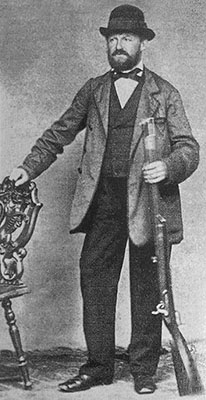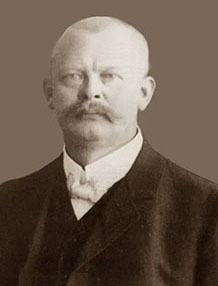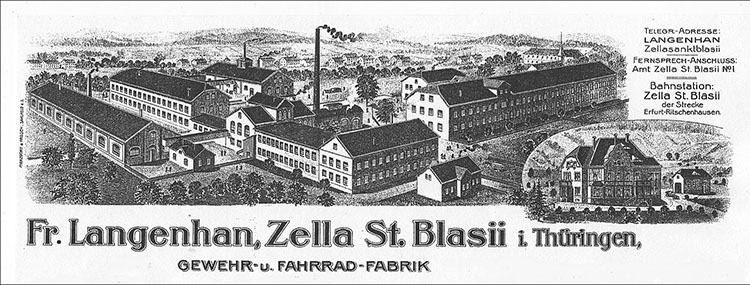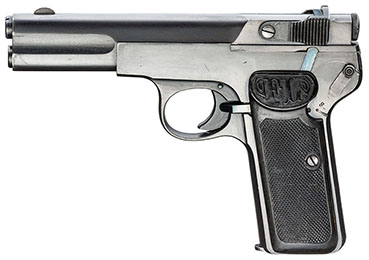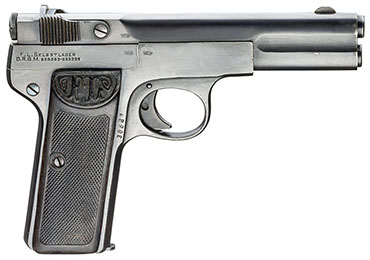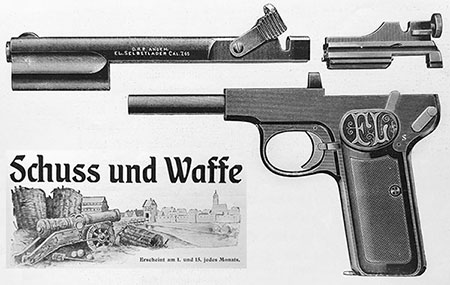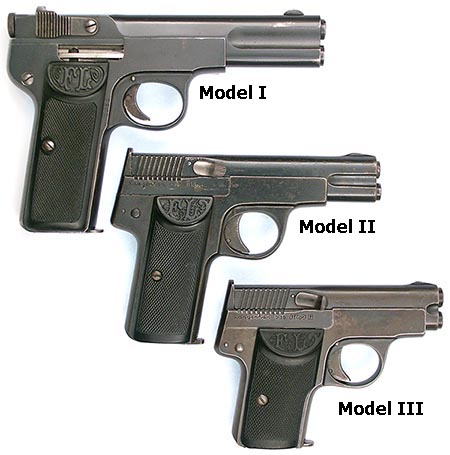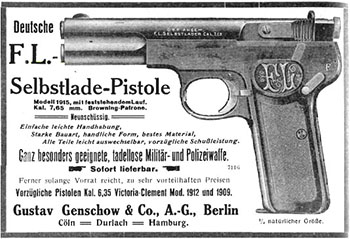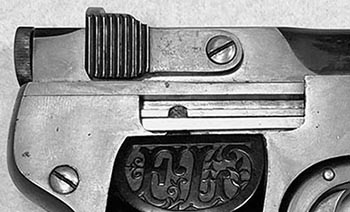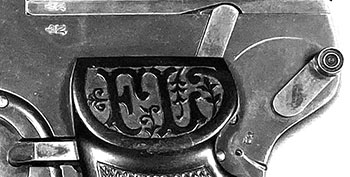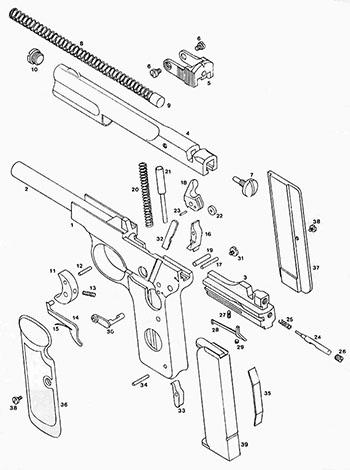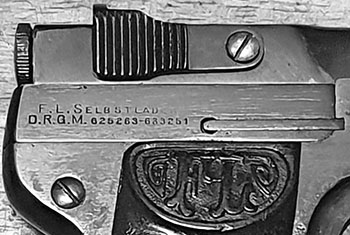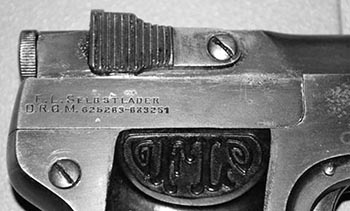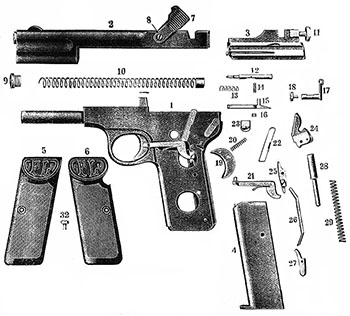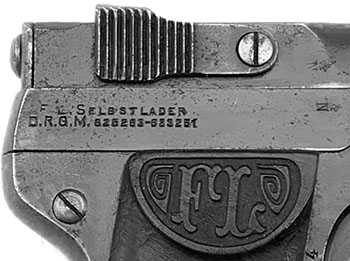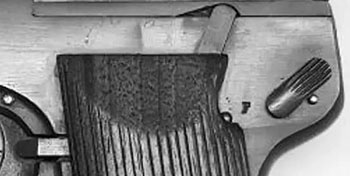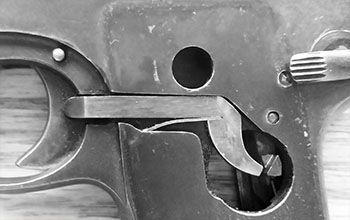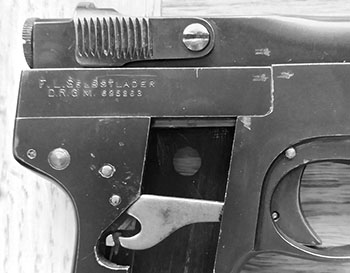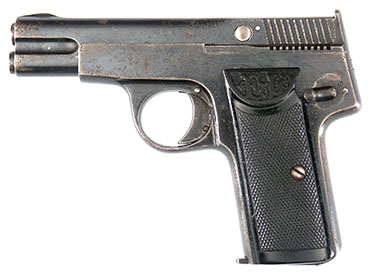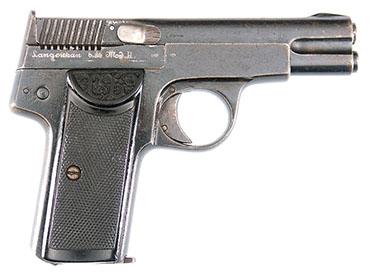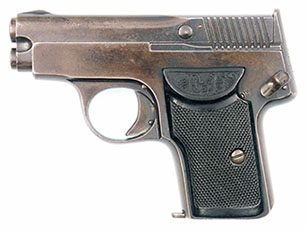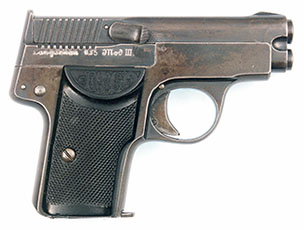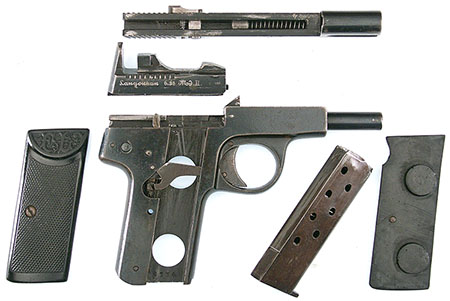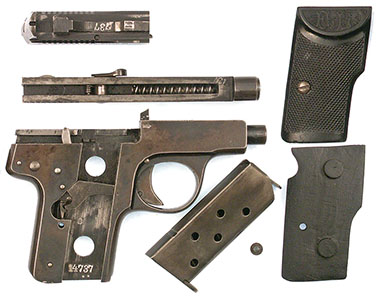 |
||||||||||||||||||||||||||||||||||||||||||||||||||||||||||||||||||||||||||||||||||||||||||||||||||||||||||||||||||||||||||||||||||||||||||||||||||||||||||||||||||||||||||||||||||||||||||||||||||||||||||||||||||||||||||||||||||||||||||||||||||||||||||||||||||||||||||||||||||
|
The Self-Loading Pistols of the by Ed Buffaloe Historical Background
An 1864 advertisement lists the company name and location as “Freidrich Langenhan, Zella by Gotha,” and states it is a “factory in guns, cast steel barrels, and especially all types of revolvers.” An 1873 advertisement in the Handbook of Industry gives the name of the company as Gewehr-Fabrik von Friedrich Langenhan (gun factory of Friedrich Langenhan) of Zella in Thuringia, “offering luxury rifles, revolvers, pistols according to all the latest systems, as well as all articles in the [firearms] field, quality guaranteed.” Friedrich’s son, Ernst Hermann Langenhan (1859-1929), took over the company in 1885, only a few years after the death of his grandfather, and a year before the death of his father, and ran it until his own death in 1929.
When World War I began, the German army ordered manufacturers to produce weapons for the war effort. The first Langenhan gebrauchsmuster (utility patent) for a self-loading pistol was filed soon after the beginning of the War, on 21 October 1914 (DRGM 625263) and was published 10 March 1915. The second gebrauchsmuster was filed 28 June 1915 and published 21 July 1915. A patent was applied for, but was never approved. Manufacture of the 7.65mm F.L. Selbstlader continued until the end of World War I and, possibly, for a short time thereafter.
During World War II, the Friedrich Langenhan company had about 400 employees and, apparently, mostly manufactured machine gun parts, and a few rifle barrels. After the war the company was absorbed into an industrial combine in the German Democratic Republic (East Germany) which was named “VEB Meteor-Werk Zella-Mehlis.”
Internally the two guns are quite different. The Langenhan is hammer- rather than striker-fired, with a coil hammer spring running down the back of the grip. A single flat spring tensions both the sear and the magazine release on the Langenhan. The Browning has a stirrup-shaped transfer bar that runs on either side of the magazine to provide a smooth, even trigger pull; a lobe on top of the left side of the transfer bar serves to disconnect it from the sear when the slide is out of battery. However, the most common Langenhan variations have an external trigger bar on the left side of the gun. The disconnector is a bar that runs in a slot cut in the left side of the frame; when the breech block moves to the rear, the disconnector is depressed and, in turn, presses down on the transfer bar, moving it out of alignment with the sear. The Langenhan breech block contains the firing pin at the front and is hollowed out at the rear to allow for movement of the hammer. A screw on back of the breech block fills the hole which allows insertion and removal of the firing pin. The 7.65mm Langenhan is far simpler to fieldstrip and clean than the Browning; it is not necessary to remove the recoil spring from its housing because it is not connected to the breech block; reassembly is quick and easy. The screw at the rear, securing the stirrup which holds the breech block to the slide, is often considered the weak point of the design but, in practice, has rarely proven to be problematic. The screw can loosen with repeated firing, but the stirrup is very tightly fitted and also serves as the rear sight and the means of retracting the slide; it is reasonably obvious when the stirrup is out of position.
There are five variations, and a number of sub-variants, of the 7.65mm Langenhan selbstlade-pistol, which was also known as the “Army pistol.” Called the “Modell 1915” in the early Gustav Genschow advertisement, it was retroactively named the Model I after the war. Manufacture may well have begun as early as October 1914. First Variation The earliest version of the Langenhan 7.65mm “ F.L. Selbstlader” pistol has an ejection port cut into the right side of the upper frame, just like the Model 1899/1900 Browning. The breech block has an external extractor on its right side which is visible in the ejection port. The manual safety lever turns a full 180 degrees. The upper position of the safety lever is the “safe” position, which blocks the hammer. In the safe position, the safety lever end protrudes from the rear of the frame just enough to be felt by the thumb of a right-handed shooter. Gordon Bruce comments: “Its operation with the shooting hand is not easy.” Its direction of motion is apparently counterintuitive as well because one almost never sees an early F.L. Selbstlader without a semicircular scratch in the finish from the safety being turned in the wrong direction. Safety lever positions are marked F and S, so the appropriate letter is uncovered when the lever is in the opposite position. The gun is rust blued, with a fire-blue trigger, transfer bar, and disconnector. The front sight is a simple half-moon. The stirrup that retains the breech block forms the rear sight. Grip plates are of checkered horn with an “FL” monogram in a flattened oval at the top. Matthews and Jan Still both state that grip plates are of hard rubber. We have located a number of grips with worm holes that are clearly made of horn, but have also seen examples that appear to be hard rubber, so it is possible that both materials were utilized; we have been unable to examine enough grip plates in person to make a clear determination. There are two styles of grip monogram, one of which is more ornate than the other (see first and second variant photos at right). The magazine holds eight cartridges and has seven witness holes on the right side with a single hole on the left side. Early guns are marked on the left side of the slide in all-capital serif characters: D. R. P. ANGEM. This indicates that a Deutches Reichs Patent has been applied for. We do not know what the patent covered, but it was apparently not granted. A gebrauchsmuster (utility model, a short-term interim patent) was most likely applied for at the same time because they were usually granted very quickly. We do not know what the gebrauchsmuster covered, but we can speculate that it may have been the stirrup that connects the breech block to the slide and/or the unusual design of the lockwork: the hammer has a roller fitted into its bottom rear, which serves to eliminate friction between it and the vertical coil spring and plunger that tensions it. We know the utility model was applied for on 21 October 1914 and was published 10 March 1915. Presumably, guns made after 10 March 1915 have the following slide inscription, indicating that the gebrauchmuster had been granted: F. L. SELBSTLADER The serial number is on the right side of the gun, behind the trigger. Many of the first variation guns are marked with a military inspection stamp in the form of a crown over a gothic letter M, R, or D, usually on the left side of the frame in front of the breech block. There are exceptions, such as the early serial numbers 522, 1285, and 1712. Jan Still estimates that the first variation ran to about serial number 8000. If you have a gun in the serial number range that might more clearly define when this first variant ended and the second began, please contact me.* Second Variation If, as we believe, the 7.65mm Langenhan “F.L. Selbstlader” went into production in late 1914, we suspect it soon became obvious that the open ejection port and external extractor on the breech block were a problem; it was far too easy for the mechanism to get fouled in the trench warfare of World War I The issue was resolved by redesigning the breech block to have an internal extractor and eliminating the open ejection port. We have encountered at least one transitional gun (SN 8040) with an external extractor that sits flush with the breech block; there may be more but, if so, they were very short lived and are extremely rare today. As Ian Hogg points out, the re-design meant that there was no longer an internal groove in the frame or a rail on the breech block on the right side, so the breech block simply runs on top of the frame. Not an ideal design, but the company went with it anyway due to the wartime imperative. We think it likely that the second gebrauchsmuster, filed on 28 June 1915 and published 21 July 1915, covered the redesigned breech block because guns with the new breech block also have a new inscription in sans-serif characters on the right side of the breech block, with an additional gebrauchsmuster number, as follows: F. L. SELBSTLADER The inscription on the left side of the slide was eliminated. Grips continued to be checkered horn with the FL monogram at the top. However, at some point in the war, the supply chain for horn broke down, and at the very end of the production range of the second variation we begin to find wooden grips with vertical grooves cut in them. Gordon Bruce points out that a few guns in the 35000 and 37000 serial number range feature a different mechanism for securing the stirrup to the breech block. Bruce states that the long locking screw “was replaced by a square end piece and fastened with a countersunk screw. At its base, the end piece was machined to match the rear part of the breech block.” We have only located two examples, one in the 37000 range that Bruce mentions, but also another in the 25000 range. Perhaps this was a factory “fix” for any gun that had problems with the rear screw coming loose. Most of the second variation guns are also marked with military acceptance stamps, but there are exceptions. Jan Still states that the Langenhan was offered for sale to officers by the German Army Arsenal in August 1917, implying that guns sold in this manner would not have acceptance stamps. The second variation runs from approximately serial number 8000 to at least 52719, making it far and away the most common variant. Please contact me if you can help make these numbers more accurate.* Third Variation The third variation of the “F.L. Selbstlader” is distinguished by a redesigned safety lever. The new safety lever is slightly shorter than the original and has five longitudinal serrations that extend a little more than half way down its length; it has a shorter throw of about 160 degrees, and the safe position is forward and the fire position is to the rear. However, the lever still turns in the clockwise direction to disengage. Positions are marked F and S, with the appropriate letter being uncovered when the lever is in the opposite position. A stud in the frame forms a stop for the safety lever at the rear. All the third variation guns we have observed have the wooden grip plates which began to appear with the last of the second variation. The third variation runs from at least serial number 54932 through at least 64090. Please contact me if you can provide additional information.* Fourth Variation The fourth variation of the “F.L. Selbstlader” is distinguished by the elimination of the external disconnector which simplified production. As Ernie Lang points out, the result of the change is that there is no slide-operated disconnector on this variant. When the trigger is pulled, the end of the transfer bar presses against an angled surface in the frame under the left grip plate which cams it down and out of contact with the sear so long as the trigger is held to the rear. Technically it would be possible for the gun to fire with the breech block partially open. The serrations on the safety lever are shortened so that they only extend halfway down; later still they are shortened further. Early guns have the half moon front sight but later guns have a redesigned front sight shaped like an isosceles triangle that is integral with the slide. Early fourth variation guns may have wooden grip plates but apparently the supply issue was resolved and horn grip plates (or possibly hard rubber) appear again on most of the guns we have observed in this range. The fourth variation runs from at least serial number 65922 through approximately serial number 73151. Please contact me if you can help make these numbers more accurate.* Fifth Variation The fifth variation of the “F.L. Selbstlader” is distinguished by the elimination of the external transfer bar. The new internal transfer bar is moved to the right side of the gun, and disconnection from the sear is accomplished in the same manner as the fourth variant and is in no way dependent on the position of the slide. The safety lever remains the same but, in very late guns, the fire position is marked by a concave area with red paint in it which is covered when the lever is in the Safe position. The Safe position is still marked with an S. Early fifth variant guns have the isosceles triangle front sight, first seen on the fourth variant, but later guns have a small wedge-shaped front sight. Early guns also have checkered horn grip plates but, at the very end of production, we begin to see wooden grip plates again. It seems likely that the company was using up the existing stock of parts. Early fifth variant guns are marked like the fourth variant. Some late guns are marked “GERMANY” or “Made in Germany.” Late guns we have observed have only the first gebrauchsmuster number in the inscription. The inscription is on the right side of the breech block and reads as follows: F. L. SELBSTLADER
Serial numbers on very late pistols are sometimes covered by the right grip plate or are found in the magazine well. The fifth variation runs from at least serial number 73443 through approximately serial number 84889. Adamek states that approximately 85,000 pistols were made in 7.65mm. Please contact me if you have a very late fifth variant gun.* The J.L. Galef company of New York was still offering the Model I “F.L.” pistol as late as 1925, along with the Model II. The December 1932 Galef catalog still shows the Model I, but states the gun is available in .25 caliber only. The September 1935 catalogue shows only the Model II.
After the war, German companies were required to stop making military guns, so the Langenhan factory quickly designed pocket-size and vestpocket-size 6.35mm pistols that could be sold commercially. They took the final design of the 7.65mm Model I, with its internal transfer bar, and miniaturized it. The only changes made were to provide a rear sight as part of the breech block and to devise a better method of connecting the breech block and slide. A rotating lever on the right side of the slide allows for a quick disconnect between the slide and breech block; disassembly can be accomplished in seconds. The Model II holds eight cartridges and the Model III holds six. Many small parts on the two guns are interchangeable.
There is no direct evidence as to exactly when production began; it could have been as early as 1919 or 1920. According to Matthews, early 1920’s catalogs of Schilling and Lepper “...illustrate the design that later became known as the Modell II, though no such designation appeared in the illustration or text. It was stated, however, that the pistol could be had for either 6 or 8 rounds....” The first post-war advertisement we have located is in the 1921 GECO (Gustav Genschow) catalog which features a picture of the Model II but lists all three models for sale by model number.
A more restrictive gun law was passed in Germany in 1928, and Langenhan’s production of auto pistols probably ended in or around this time, but Langenhan pistols continued to be sold from stock into the 1930’s. The Model II is listed in the AKAH catalog of 1929, and the Model III is listed in the 1932 WUM catalog. The 1932 GECO (Gustav Genschow) catalog does not list the F.L. pistols but lists spare magazines for all three models. The J.L. Galef company of New York still lists the Model II in their September 1935 catalog. The finish is rust blue. Early guns have wooden grips like the late Model I, with vertical serrations. Later guns have horn grips with the FL monogram in a flattened oval at the top. The breech block has ten flat-bottomed plunge-milled serrations on each side. Some guns are marked “GERMANY” or “Made in Germany.” The inscription is in script on the right side of the breech block, as follows: Langenhan 6,35 or Langenhan 6,35 Mod.II or Langenhan 6,35 Mod.III The only variations we have noted are that some guns have the model number on the slide and some do not, and some of the Model III guns have a Chicago screw in place of the quick-disconnect lever on the slide. We think it likely that the Models II and III share the same serial number sequence. The highest serial number we have observed is 28895, which is a Model III. Serial numbers are stamped in the magazine well of most guns, but some are found on the bottom of the grip frame. Partial serial numbers are stamped on the breech block and slide. Please contact us if you have one of these pistols and are willing to share photographs and serial number information.*
*Write to edbuffaloe@unblinkingeye.com. |
||||||||||||||||||||||||||||||||||||||||||||||||||||||||||||||||||||||||||||||||||||||||||||||||||||||||||||||||||||||||||||||||||||||||||||||||||||||||||||||||||||||||||||||||||||||||||||||||||||||||||||||||||||||||||||||||||||||||||||||||||||||||||||||||||||||||||||||||||
|
||||||||||||||||||||||||||||||||||||||||||||||||||||||||||||||||||||||||||||||||||||||||||||||||||||||||||||||||||||||||||||||||||||||||||||||||||||||||||||||||||||||||||||||||||||||||||||||||||||||||||||||||||||||||||||||||||||||||||||||||||||||||||||||||||||||||||||||||||
|
Copyright 2021 by Ed Buffaloe. All rights reserved. |
||||||||||||||||||||||||||||||||||||||||||||||||||||||||||||||||||||||||||||||||||||||||||||||||||||||||||||||||||||||||||||||||||||||||||||||||||||||||||||||||||||||||||||||||||||||||||||||||||||||||||||||||||||||||||||||||||||||||||||||||||||||||||||||||||||||||||||||||||
|
|
||||||||||||||||||||||||||||||||||||||||||||||||||||||||||||||||||||||||||||||||||||||||||||||||||||||||||||||||||||||||||||||||||||||||||||||||||||||||||||||||||||||||||||||||||||||||||||||||||||||||||||||||||||||||||||||||||||||||||||||||||||||||||||||||||||||||||||||||||
